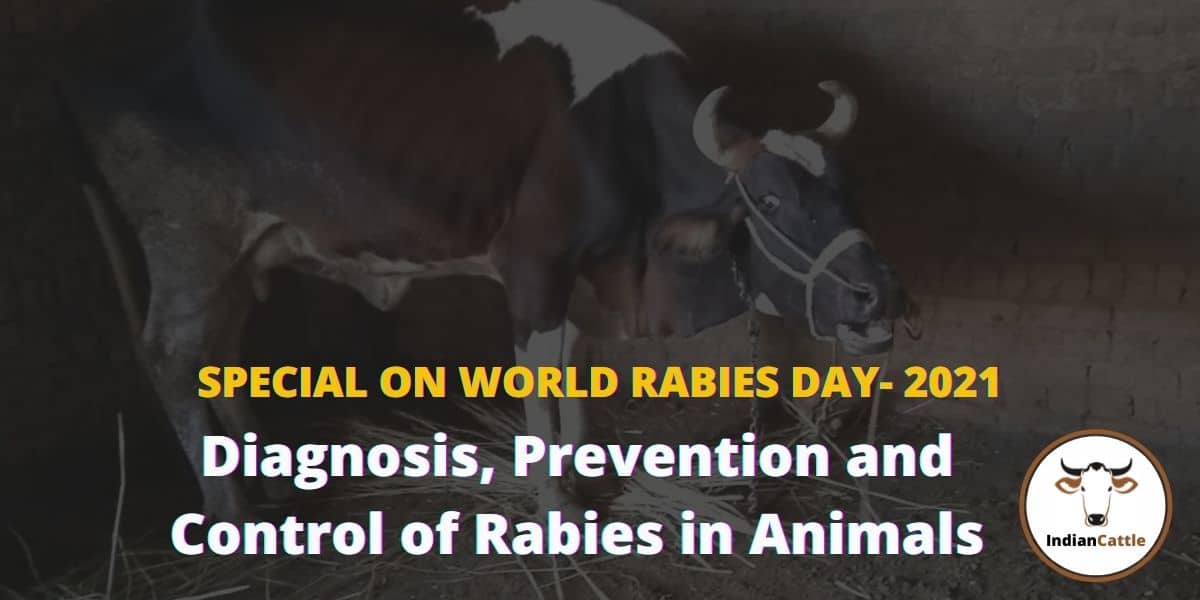
SPECIAL ON WORLD RABIES DAY – Diagnosis, Prevention and control of Rabies in Animals
Rabies is a viral and zoonotic disease transmitted to animals and humans, commonly through bite of an animal shedding the virus in the saliva or oral secretions. The virus affects central nervous system and causes hyperactivity and possible paralysis of the limbs due to motor neuron damage. Rabies was an endemic disease in many countries but with global cooperation, this disease has been stamped out from many countries. In India cases of rabies are recorded scarcely due to concerted efforts of the veterinarians and the pet owners. Rabies in wildlife continues to be a problem in the rabies transmission chain, the world over. Dogs are the main source of human rabies deaths, contributing up to 99% of all rabies transmissions. As zoonotic disease rabies is included in WHO’s new 2021-2030 road map.
Causal Organism: Rabies virus – family Rhabdo viridae.
Susceptible Animals: All mammals, including, dogs, cattle, cats, foxes, pigs, horses, skunks, bandicoots, vampire bats, rabbits, and wild animals. In the scale of susceptibility, cattle are thought to be the most susceptible.
Disease Transmission: Rabies is transmitted through bites of rabid animals, licking of the wounds, abrasions caused by rabid animals and spending long hours in the close vicinity of the vampire bats. Once clinical symptoms appear, rabies is virtually 100% fatal. People can get infected following a deep bite or scratch from an animal with rabies. In up to 99% of cases, domestic or stray dogs. At the time of bite, the shedding of virus in the saliva is an important factor, as sometimes, even normal dogs are known to shed virus intermittently.
Incubation Period and Pathogenesis: After a bite or other rabies exposures, rabies virus must transmit through the body to the brain, before it can cause symptoms. The time between the exposure and appearance of symptoms is called the incubation period. The incubation period in rabies depends on several factors, the site of wound that is exposed to the saliva of an infected animal, the intensity of innervation and the virus load in the saliva. The incubation period therefore is variable ranging from 2-4 weeks to in rate cases more than a year. The disease has also been reported in cattle, buffalo and other warm-blooded animals.
Clinical symptoms: The symptoms appear in three stages.
- Prodromal stage – It lasts for 2-3 days, sickness, behavioural changes, fearlessness, aggression, refuse to take food, rise in temperature.
- Excitement stage – It results in hyperactivity, excitable behaviour, excessive drooling, hydrophobia, and sometimes aerophobia, animal becomes increasingly irritable and restless, tending to eat unusual objects, tendency to attack and bite.
- In dumb rabies, animal avoid people and hide in dark places, change in barking tone due to pharyngeal paralysis and salivation.
- Paralytic stage –Muscles gradually becomes paralysed starting at the site or scratch, Paralysis of whole body, coma slowly develops and death occurs.
- In cattle, frequent yawning due to pharyngeal irritation is a common pathognomonic symptom.
Post- mortem Findings: If an animal is suspected to rabies, the post-mortem should be avoided or handled with due care, following proper protective clothing, necessary equipment. The presence of foreign bodies and absence of feed material in stomach indicates the possibility of rabies and glycosuria have been recorded.
Specimens to be collected for laboratory Investigation: For submission of the laboratory material for diagnosis, standard protocol must be followed. If possible, corneal impression smears from the ailing animal can be taken for inclusion body examination. On post-mortem brain, with stem (Hippocampus) in 50% glycerine saline or on ice, is ideal for the tests.
Differential Diagnosis: Encephalitis, surra, enterotoxaemia in sheep, distemper and lead poisoning.
Diagnostic Tests:
Post-Suspected- Rabies-Bite Management: With due care, thorough washing of the wounds in running tap water, with detergent soap, carried out as early as possible helps in reducing the virus invasion in the tissues. But once symptoms appear, rabies vaccine and immunoglobulin are not effective and death is almost certain.
- Post bite vaccination to be commenced immediately after bite.
- Prophylactic (pre bite) vaccination of pet and stray dogs. Birth control programmes are a sure way of controlling rabies.
- Prevention and Control: Vaccination programmes and control of stray animals have been effective in preventing rabies. Prophylactic vaccination and post bite vaccination as per manufactures instructions should be given.
- If cattle farms are in the vicinity of forests infested with foxes and jackals and if the area is endemic to rabies in cattle, preventive vaccination of cattle with rabies vaccine should be carried out.
You may like to read: Flies in the Farm? Your Cows May Have This Disease
| Dr. V. M. Bhuktar
Former I/c Joint Commissioner A. H. Western Regional Disease Diagnostic Laboratory (WRDDL) Pune M.S |
Dr. K. R. Shingal
B.V.Sc. & A.H., M.V.Sc., N.D.B.P |
